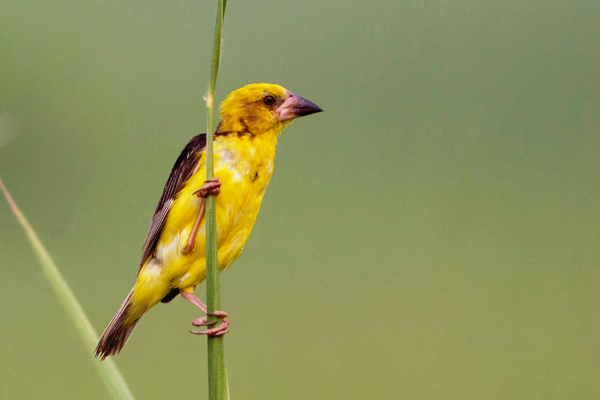Endemic to the Indian subcontinent and tagged vulnerable by the International Union for Conservation of Nature (IUCN), a colony of Finn’s Weaver birds were sighted recently by forest officials in the Terai Central forest division of Uttarakhand after many decades, forest officials said. More than 20 nests of the bird were spotted by forest officials.
The Finn’s Weaver or Yellow Weaver was first spotted in Uttarakhand in the 1950s by eminent ornithologist Dr Salim Ali. The bird, usually found in areas near agricultural fields or the Terai region, has seen a decline in population since the past few decades and experts called the sighting a ‘pleasant surprise’.
Dhananjai Mohan, Director of the Wildlife Institute of India (WII) and co-author of the ‘Updated Checklist and Bibliography of the Birds of Uttarakhand’ said that the Finn’s Weaver is a bird found only in the Indian subcontinent and it has not been sighted in the past few decades.
“This bird has been spotted after many decades in the state. There has been a continuous decline in the population of this bird in the past few decades. In the last couple of years, there has been no confirmed sighting and it had become very depressing but now a colony has been seen, which has come as a big surprise,” Mohan said.
The updated checklist of birds in Uttarakhand which Dhananjai Mohan co-authored with Sanjay Sondhi, lists 710 bird species in Uttarakhand, an increase from the first detailed checklist in 2003 that had listed 623 avian species in the Himalayan state.
Mohan added that Finn’s Weaver is found only in the Indian subcontinent; Uttarakhand, Kaziranga in Assam and Shuklaphanta region in Nepal.
“This bird has a very patchy, small population in a few select places in the Indian subcontinent. There are many species of weavers found in India, but this is the most threatened species, unlike Baya Weaver which is found commonly. Traditionally Finn’s Weaver birds form nests on large Semal trees, but we still don’t know too much about this bird, which is why perhaps new discoveries are being made and the bird has been found nesting over reeds in a water body this time,” added Mohan.
The Uttarakhand forest department along with the Wildlife Institute of India is monitoring the nesting process of the bird, taking steps to ensure that there is no disturbance and the breeding of the birds takes places successfully, “as this is an important step in the lifecycle of the bird”.
Finn’s Weaver or Finn’s Baya (Ploceus megarhynchus) builds nests on tops of trees or in reeds. According to ornithologists, they breed from May to September and line the inside of their nests, unlike other weaver birds.
Asad Rahmani, former director of the Bombay Natural History Society (BNHS) said that the spotting of Finn’s Weaver is extremely rare.
“Sightings of Finn’s Weaver are extremely rare and the current sighting is an interesting record as it has come from nesting sites. Along with Uttarakhand, there was a sighting in Bijnor region of Uttar Pradesh also and I hope the government will protect the areas where the birds were sighted. What is needed now is the protection of the habitat, as at most places nesting sites have been converted into housing colonies and almost over 90% of the habitat is gone…” said Rahmani.
Rahmani added that around 1000 birds of Finn’s Weaver species is likely to be found across the world now.
Abhilasha Singh, divisional forest officer (DFO) Terai Central forest division said that the sighting of these rare birds has come as a motivation for the forest staff.
“The birds were sighted in the Rudrapur region of Terai Central forest division by our forest staff. As the bird is not found commonly and it had not been sighted in the past few years, this sighting comes as motivation for our forest staff. We had asked all our forest staff to report sightings of any birds similar to the Finn’s Weaver and that is how we learnt about it,” Singh said.
Uttarakhand has rich avian diversity. Of the 710 species found in the state, 6 species are listed as “critically endangered” in the ‘IUCN Red List of Threatened Species’, 3 as “endangered”, 19 as “vulnerable” and 28 as “near threatened”.
Source: HT
Image Courtesy: Wikimedia
You may also like
-
New Heat-Based Approach To Cancer Treatment Can Reduce Chemotherapy Doses
-
Scientists Take A Major Step Towards Unification Of Classical & Quantum Gravity
-
India Graphene Engineering and Innovation Centre (IGEIC) Under the Vision of Viksit Bharat@2047 Launched
-
New High-Performance Gas Sensor can Monitor Low Level Nitrogen Oxides Pollution
-
Antidepressant Drug can be Repurposed for Treating Breast Cancer
